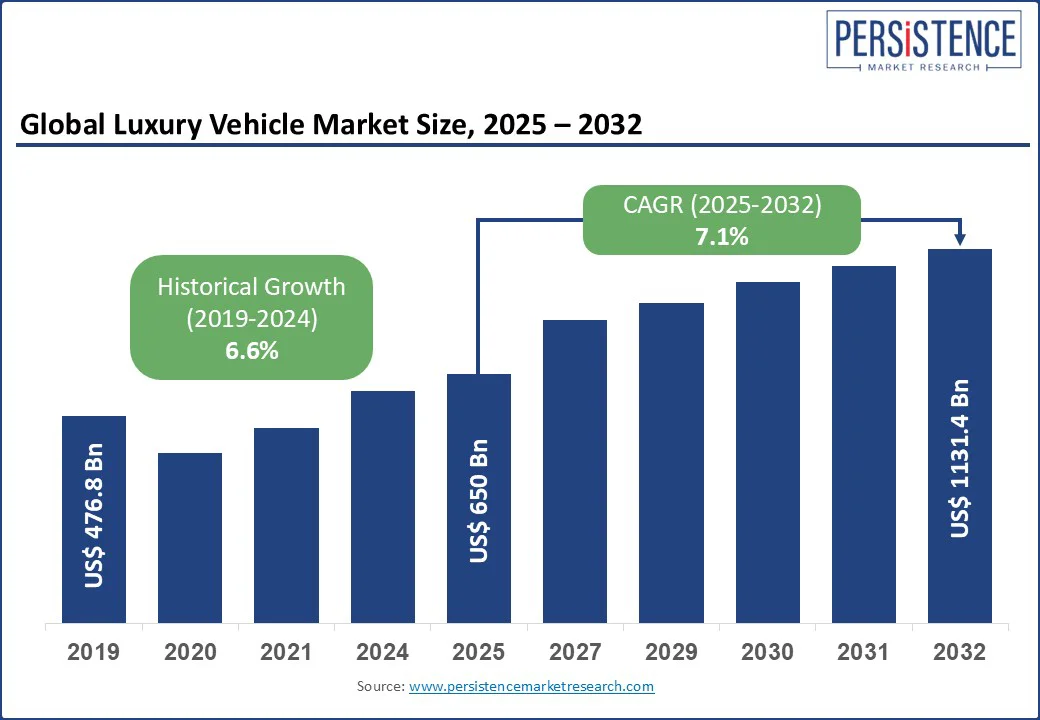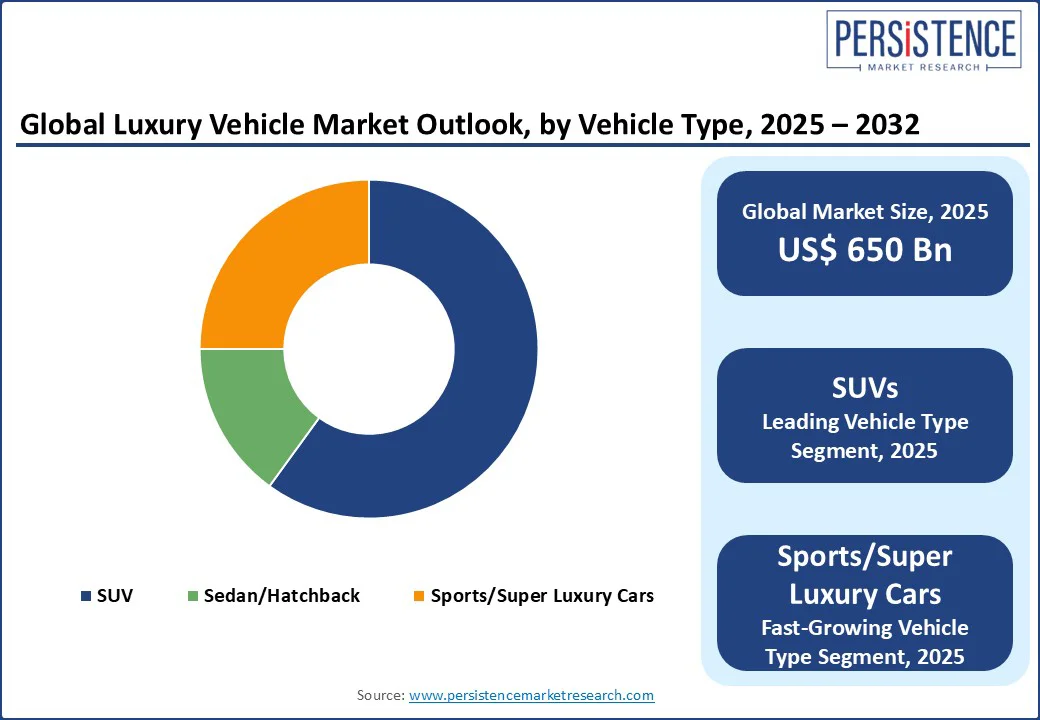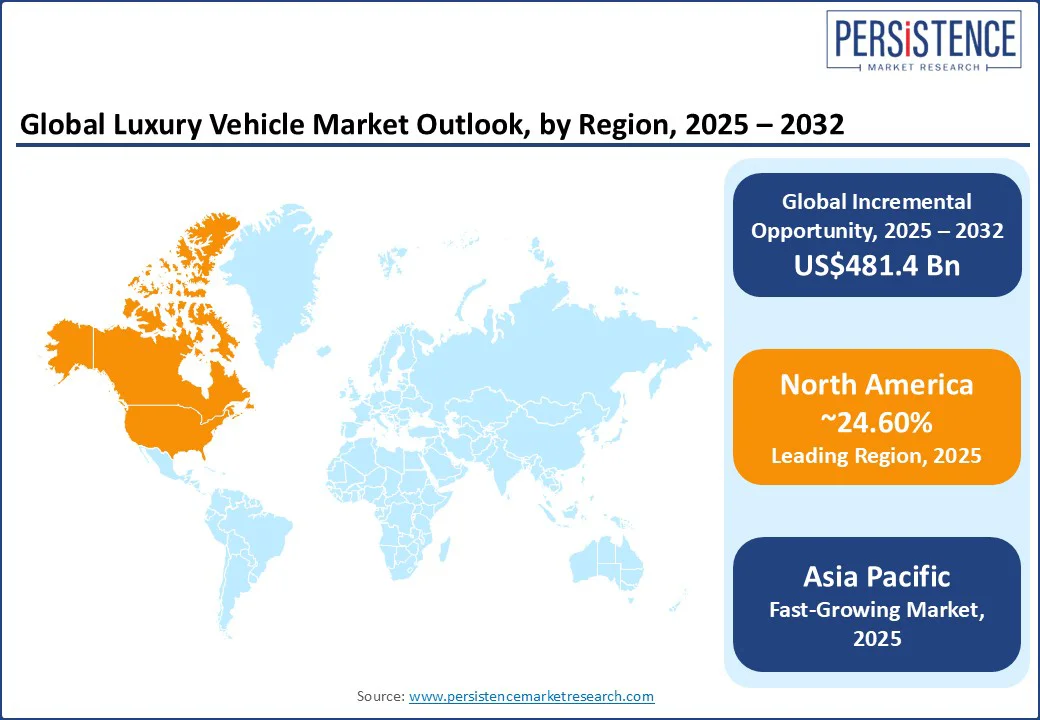ID: PMRREP2792| 190 Pages | 28 Aug 2025 | Format: PDF, Excel, PPT* | Automotive & Transportation

The global luxury vehicle market size is projected to grow from US$650.0 Bn in 2025 to US$1131.4 Bn by 2032, registering a CAGR of 7.1% during the forecast period from 2025 to 2032.
The luxury vehicle industry continues to grow steadily, driven by a rising population of high-net-worth individuals, technological advancements, and a consumer preference for sustainable yet high-performance models.
Advanced features, including AI-driven systems, connectivity, and electric powertrains, are redefining premium mobility, making luxury vehicles more appealing to affluent, eco-conscious buyers worldwide.
Key Industry Highlights:

|
Global Market Attribute |
Key Insights |
|
Luxury Vehicle Market Size (2025E) |
US$650.0 Bn |
|
Market Value Forecast (2032F) |
US$1131.4 Bn |
|
Projected Growth (CAGR 2025 to 2032) |
7.1% |
|
Historical Market Growth (CAGR 2019 to 2024) |
6.6% |
The global increase in high-net-worth individuals (HNWIs) and ultra-high-net-worth individuals (UHNWIs) is a key driver of the luxury vehicle market. According to the 2024 World Wealth Report, over 22.8 million HNWIs exist globally, with their combined wealth exceeding US$86 trillion. The number of UHNWIs is projected to grow significantly in the coming years, particularly in emerging markets such as the Asia Pacific. This wealth surge drives demand for luxury vehicles as symbols of status and success. In the U.S., the number of millionaires has been increasing annually, boosting sales of luxury SUVs and sedans for personal and corporate use.
Technological advancements in vehicle design, connectivity, and autonomous driving are propelling market growth. Modern systems, such as Tesla’s Full Self-Driving suite and BMW’s iDrive, offer enhanced safety, infotainment, and semi-autonomous features, improving user experience.
A recent study by the Insurance Institute for Highway Safety found that vehicles equipped with advanced driver-assistance systems have lower crash rates compared to traditional models. The integration of AI, 5G connectivity, and lightweight materials, such as carbon fiber, further supports adoption in high-performance segments, including sports and super luxury cars.
Government incentives for electric and hybrid vehicles, coupled with increased funding for sustainable mobility, also drive market expansion. In China, subsidies under the New Energy Vehicle policy have expanded access to luxury EVs, increasing demand for models such as the Mercedes-Benz EQS and NIO ES8. In Europe, tax incentives for low-emission vehicles incentivize consumers to invest in electric and hybrid luxury models, further boosting market growth.
High costs of luxury vehicles remain a significant barrier to widespread adoption, particularly in economically volatile regions. These vehicles, equipped with premium materials, advanced infotainment systems, and electrified powertrains, command substantial upfront investments. For example, the starting price of a Rolls-Royce Phantom exceeds US$600,000, excluding maintenance, insurance, and charging/fuel costs. In regions such as Latin America and parts of South Asia, where disposable incomes are lower, these financial burdens limit market penetration, even among aspirational buyers. The high cost of ownership underscores the need for affordable luxury models or flexible financing options to broaden market access.
Economic uncertainty and supply chain disruptions further hinder market growth. The global semiconductor shortage delayed luxury vehicle production, with reports estimating a significant shortfall in deliveries across Europe and North America. Fluctuating raw material prices, particularly for lithium and cobalt used in EV batteries, add to production costs, restricting the scalability of advanced models in developing regions. These challenges create barriers for both manufacturers and consumers, slowing market expansion.
The development of electric and hybrid luxury vehicles presents significant growth opportunities, particularly in urban environments and eco-conscious markets. These vehicles address environmental concerns and align with global sustainability goals, making them ideal for regions with stringent emissions regulations.
For instance, Volvo’s EX90, a fully electric luxury SUV, combines high performance with zero-emission capabilities, appealing to environmentally aware consumers. As governments worldwide prioritize green mobility, evidenced by initiatives such as the EU’s Green Deal and China’s NEV mandates, demand for electric luxury vehicles continues to rise, especially in regions with expanding charging infrastructure.
The rise of autonomous driving technologies offers another growth avenue. Higher levels of autonomy, as seen in models such as the Mercedes-Benz EQS and the BMW i7, enhance safety and convenience through the use of advanced sensors and AI. A recent study by the European Automobile Manufacturers’ Association found that autonomous luxury vehicles improved travel efficiency compared to manual driving, driving demand for innovative features. These advancements cater to affluent consumers seeking cutting-edge technology and seamless driving experiences.
The growing adoption of digital platforms for vehicle customization and sales also enhances market potential. Companies such as Aston Martin and Porsche are integrating virtual reality (VR) and augmented reality (AR) configurators, allowing customers to personalize vehicles remotely. This trend, combined with online sales platforms, supports market expansion by enhancing accessibility and catering to consumer preferences for personalized luxury experiences.
The global luxury vehicle market is segmented into SUVs, Sedans/Hatchbacks, and Sports/Super Luxury Cars. SUVs dominate the worldwide luxury vehicle market, holding approximately 60% of the market share in 2025, due to their versatility, spacious interiors, and appeal for both urban and off-road use. Models such as the Range Rover and BMW X7 are favored for their blend of luxury, performance, and practicality, making them popular among families and business professionals.
Sports and Super Luxury Cars are the fastest-growing segment, driven by increasing demand for high-performance and exclusive models. Innovations in hybrid powertrains and aerodynamics, such as those featured in Ferrari’s SF90 Stradale and Lamborghini’s Revuelto, enhance the appeal among enthusiasts, boosting adoption in premium markets like Europe and North America.
The luxury vehicle market is divided into Electric/Hybrid and ICE. ICE vehicles are expected to lead with a 65% share in 2025, driven by their established infrastructure, long-range capabilities, and proven performance. Models such as the Bentley Continental GT rely on powerful internal combustion engines to deliver superior speed and refinement, maintaining dominance in segments such as SUVs and sedans.
Electric/Hybrid vehicles are the fastest-growing segment, fueled by rising environmental awareness and advancements in battery technology. The success of models like Tesla’s Model S Plaid and Porsche’s Taycan, coupled with the expansion of charging networks, drives demand for sustainable luxury vehicles in progressive markets.

In North America, the U.S. leads the luxury vehicle market, with a share of about 24.60% in 2025. Driven by high disposable incomes, strong brand loyalty, and well-established charging infrastructure. This dominance reflects a growing appetite for premium SUVs and electric models, supported by a significant annual volume of luxury vehicle sales. Leading brands such as Tesla and Cadillac continue to innovate, offering advanced models such as the Tesla Model X and Cadillac Celestiq, which combine cutting-edge design with high performance to cater to affluent consumers seeking both sustainability and luxury.
Consumer preferences are rapidly evolving toward sustainable and connected vehicles, prompting automakers to integrate advanced technologies. Companies such as General Motors are pioneering AI-driven safety features and incorporating 5G connectivity, enabling enhanced infotainment, real-time navigation, and semi-autonomous driving capabilities.
Environmental regulations from agencies such as the EPA further accelerate the shift toward hybrid and electric vehicles, aligning with broader climate goals. Additionally, favorable financing options, flexible leasing programs, and government incentives for luxury EVs are making these vehicles more accessible, fueling adoption across urban and suburban markets. This blend of technological innovation, regulatory support, and financial accessibility ensures continued growth in the U.S. luxury vehicle sector.
Europe’s market is led by Germany, the U.K., and France, driven by regulatory support and high demand for premium brands. Germany holds the largest share, supported by strong sales from BMW AG and Mercedes-Benz Group AG. The EU’s Green Deal fosters innovation, encouraging the adoption of electric/hybrid systems and advanced connectivity in models such as the Audi e-tron GT.
In the U.K., market growth is driven by rising demand for sustainable luxury vehicles. Models such as the Bentley Flying Spur Hybrid are gaining traction for their eco-friendly performance. France sees an increased demand for sports and super-luxury cars, with Bugatti’s Chiron leading in exclusivity. Regulatory support for sustainable manufacturing further enhances market prospects across Europe.
Asia Pacific is the fastest-growing region in the luxury vehicle market, driven by increasing affluence, rapid urbanization, and strong government support for sustainable mobility. Countries such as China, India, and Japan are leading this growth trajectory, supported by rising consumer demand for advanced and environmentally friendly vehicles.
In China, generous government incentives under the New Energy Vehicle (NEV) policy and expanding charging infrastructure have boosted the adoption of electric luxury models such as the NIO ET7 and BYD Han EV. This surge reflects the country’s push toward carbon neutrality and its rapidly growing segment of high-net-worth individuals.
India’s luxury vehicle market is also experiencing significant momentum, driven by a growing middle class, rising disposable incomes, and an increasing aspiration for premium lifestyles. Brands like Tata Motors, through models like the Jaguar F-Pace, are leveraging these trends to capture consumer interest.
Japan emphasizes high-precision engineering and advanced safety technologies, with Toyota’s Lexus brand strengthening its market position. Additionally, the region’s investment in digital sales platforms and EV infrastructure is accelerating adoption, making the Asia Pacific a pivotal hub for future luxury vehicle innovation and sales growth.

The global luxury vehicle market is fiercely competitive, with global and regional players focusing on innovation, brand heritage, and sustainability. The growing adoption of electric and autonomous technologies heightens rivalry as manufacturers strive to meet strict emission norms and evolving consumer expectations. Strategic alliances, mergers, and timely regulatory approvals are critical for differentiation and long-term market leadership.
The luxury vehicle market is projected to reach US$650.0 Bn in 2025.
Rising high-net-worth individuals, technological advancements, and government incentives for electric vehicles are the key market drivers.
The luxury vehicle market is poised to witness a CAGR of 7.1% from 2025 to 2032.
Innovation in electric systems and autonomous driving technologies is the key market opportunity.
BMW AG, Mercedes-Benz Group AG, and Tesla are among the key market players.
|
Report Attribute |
Details |
|
Historical Data/Actuals |
2019 - 2024 |
|
Forecast Period |
2025 - 2032 |
|
Market Analysis |
Value: US$ Bn Volume: As Applicable |
|
Geographical Coverage |
|
|
Segmental Coverage |
|
|
Competitive Analysis |
|
|
Report Highlights |
|
|
Customization and Pricing |
Available upon request |
By Vehicle Type
By Propulsion Type
By Region
Delivery Timelines
For more information on this report and its delivery timelines please get in touch with our sales team.
About Author